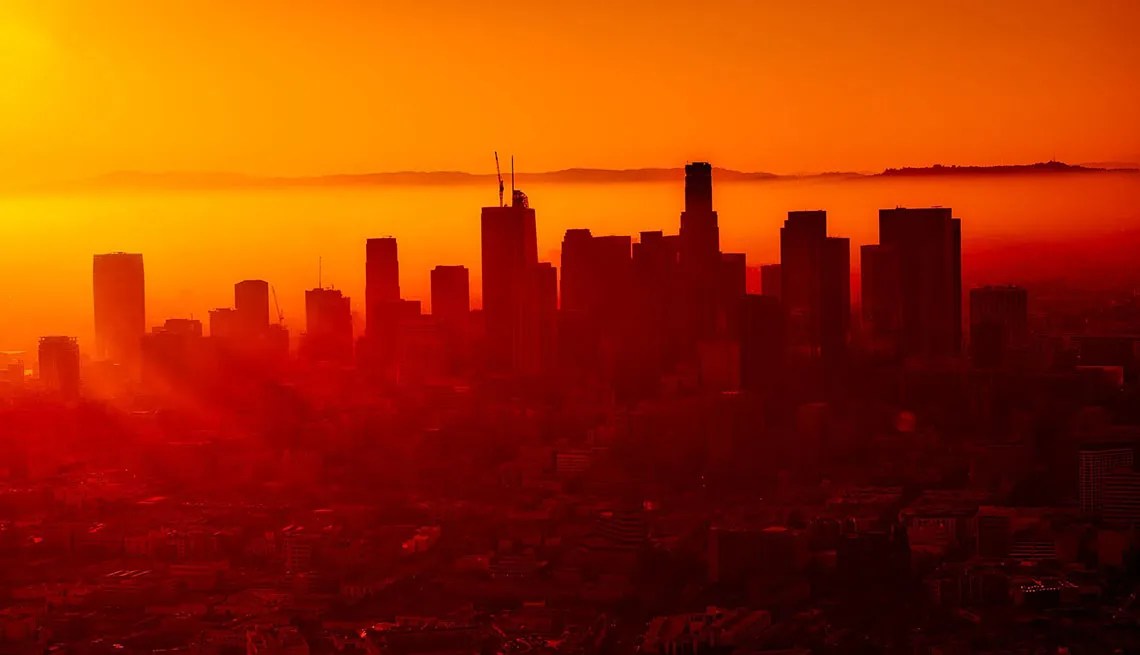Cities are Heating Up—Here's How Urban Planners Should Prepare
As heat waves blaze across the United States, CAPLA's Ladd Keith says city planners should take the lead in managing and mitigating extreme heat.

Photo by David Mark, courtesy Pixabay.
By Kyle Mittan, University Communications
Tucson didn't quite set a record during the National Weather Service's excessive heat warning over the weekend, but at a certain point, who can really tell the difference?
Temperatures topped out at 109 degrees Fahrenheit on Saturday, just shy of the date's record high of 111, set in 1933. It was a scorcher, but not as bad as what Lytton, British Columbia, experienced last summer. The village in Western Canada, which has a population of fewer than 300 people, saw the temperature hit 121 degrees last June 30. The heat wave in Lytton led to a wildfire that destroyed nearly 90% of the village. Its residents are now rebuilding.
The record-setting temperatures and devastating fire in Lytton were among the results of a series of heat waves that swept North America last summer and were also felt in Tucson.

Ladd Keith, Assistant Professor of Planning and Sustainable Built Environments
As extreme heat becomes more persistent and prevalent, and as the U.S. braces for a new season of heat waves, Ladd Keith, an assistant professor of planning and sustainable built environments in the UArizona College of Architecture, Planning and Landscape Architecture, says city planners can and should lead their communities in managing and mitigating extreme heat.
Keith and Arizona State University researcher Sara Meerow recently wrote a report, published by the American Planning Association, that gives planners a set of principles and guidelines to equitably address extreme heat in their communities. The report, Planning for Urban Heat Resilience, is guided by Keith and Meerow's research on heat and climate planning, and is available to download for free.
Keith talked to University of Arizona News about the causes of extreme heat, how heat impacts more than just public safety and what those of us who aren't city planners can do to help manage and mitigate this growing threat:
Your report focuses on two main causes of increasingly extreme heat: climate change and the urban heat island effect. Can you explain the urban heat island effect and why it's important for cities to address both causes?
The urban heat island effect—when urban areas are hotter than the surrounding rural areas—results from how cities are built using heat-trapping materials such as asphalt for roads; the shape and form of the built environment; and the loss of natural landscapes. Waste heat from our vehicles and air conditioning also increase the urban heat island effect.
Climate change has already increased average temperatures and has made extreme heat events more frequent, longer and more intense. These both compound each other and create more heat risk for our communities. The good news is that we can plan our communities to mitigate both urban heat and greenhouse gas emissions if we choose to.
Your report notes that extreme heat is the No. 1 weather-related killer in the U.S., making public safety a critical focus. What are some of other effects of heat on cities?
A new study by The Nature Conservancy and the American engineering firm AECOM found that if increasingly extreme heat is not addressed, the economic consequences to the Phoenix metro region will cost between an average of $1.9 billion and $2.3 billion each year by 2059. These staggering numbers include increased costs to public health, labor, roadway infrastructure and energy demand. They also found that investments in heat mitigation strategies far outweigh the cost of inaction.
How did you come up with the seven considerations for heat planning that you lay out in the report?
Many communities are just now beginning to plan for heat, so we thought it was important to offer a practical framework to help ensure urban heat resilience planning efforts are as effective and equitable as possible. With that in mind, we used our research on heat planning to refine the seven principles for strong climate change planning—which my co-author, Sara Meerow, helped define—for the challenges and opportunities that are specific to heat.
The seven considerations for heat planning are:
- Setting clear heat planning goals and metrics
- Building a comprehensive fact base of heat information
- Developing a portfolio of heat mitigation and management strategies
- Managing for uncertainty
- Coordinating across all planning efforts
- Using an inclusive public participation process
- Implementing, monitoring and evaluating the effectiveness of heat planning efforts
Is there a city that already does heat mitigation and management well?
There isn't one example just yet, since heat planning is still so new, but we highlight exciting examples of innovation throughout our report. For heat mitigation, the city of Tucson and Tucson Water are leading the way on green stormwater infrastructure to help mitigate the urban heat island effect while conserving our water resources. For heat management, the Maricopa Association of Governments and partner communities and organizations have helped coordinate their cooling centers in Phoenix through the Heat Relief Network, a network of partners providing cooling centers, hydration stations and water donation sites throughout the Phoenix area.
For a city that addresses both, though, I'm keeping an eye on the city of Boston. They just finalized their Heat Resilience Solutions for Boston report, which comprehensively addresses both heat mitigation and management. It will be interesting to see how their recommendations are implemented and if other cities follow their example.
What other promising progress have you seen?
Miami, Phoenix and Los Angeles recently created dedicated staff positions, such as chief heat officers, to help coordinate and direct their heat planning efforts. This is an exciting development that shows communities are taking the growing risk of extreme heat seriously, but many medium and smaller-sized communities and rural areas across the U.S. likely don't have the resources to create a dedicated position for heat. We hope our report offers practical guidance that all communities, regardless of resources, can use to help advance their urban heat resilience efforts.
How does extreme heat disproportionately affect marginalized communities, and what are some tools planners have to make urban heat resilience more equitable?
Several studies have established that historic discriminatory land use and financial practices, such as redlining (a discriminatory practice whereby banks refused loans to people from certain ethnic backgrounds or neighborhoods), have resulted in neighborhoods that to this day are hotter, by as much as 12.6 degrees Fahrenheit based on land surface temperatures, compared to non-redlined neighborhoods. Systemic inequities also increase heat risk, such as quality of homes, access and reliability of energy for indoor cooling, access to healthcare, and thermally safe workplaces and schools.
Although we make many recommendations in our report on how to plan equitably for urban heat, two primary considerations for planners are to focus on inclusive public participation—to ensure all community voices are heard—and to target heat mitigation investments in the areas that have highest heat risk, such as formerly redlined neighborhoods.
What kind of feedback have you received from planners who have seen the report?
The report is free to download, thanks to a grant from the National Oceanic and Atmospheric Administration, and has been pretty widely shared, especially by federal agencies and nongovernmental organizations that work directly with local communities. We've gotten great feedback from planners and other local practitioners, mostly along the lines of, "This is exactly the information and guidance what we needed to get started," which was one of our main goals in writing it. Although our audience was U.S. communities, we've had great feedback from international practitioners, too.
These recommendations are for planners, but what can the average person do—for themselves or their communities—to help manage and mitigate extreme heat?
Everyone can prepare beforehand for heat and be more familiar with the signs of heat-related illness. During hot periods, we should limit our daytime outdoor activities, stay hydrated, keep pets inside and check on family, friends and neighbors who may be at high risk.
Homeowners can choose drought-tolerant trees and use water harvesting in their yard, weatherize their homes through insulating walls and roofs and weather-stripping doors and windows, and select energy-efficient appliances and air conditioning when upgrades are necessary. Renters should be aware that landlords in Arizona are required to provide sufficient cooling and that they have a right to safe indoor temperatures.



